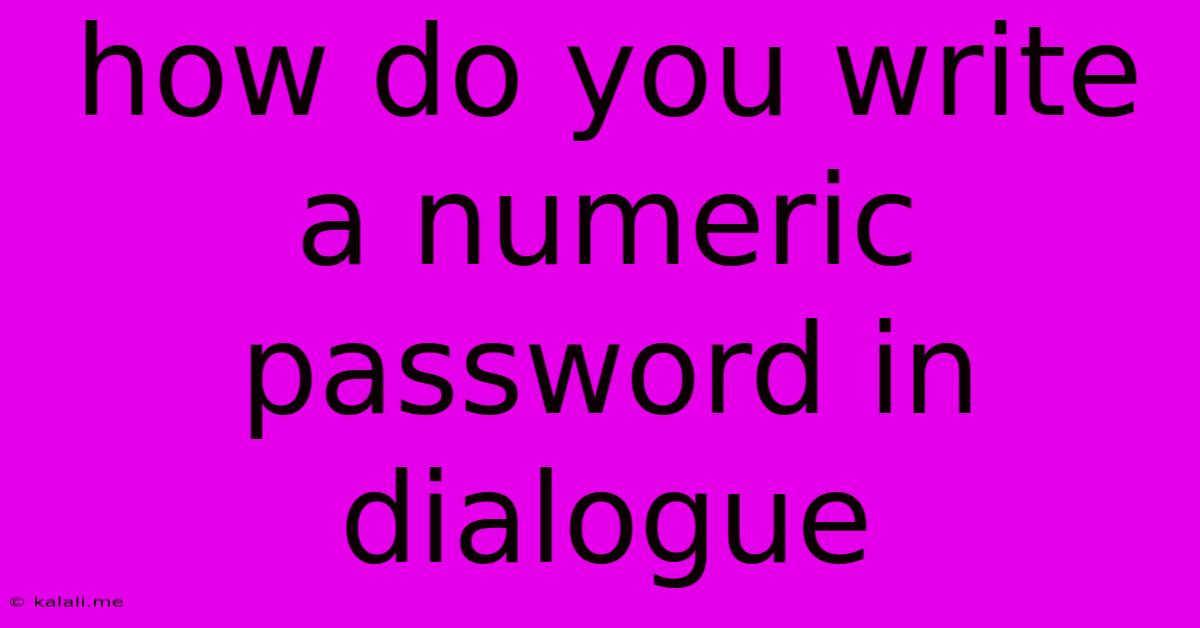How Do You Write A Numeric Password In Dialogue
Kalali
May 23, 2025 · 3 min read

Table of Contents
How Do You Write a Numeric Password in Dialogue?
Writing dialogue that includes passwords, especially numeric ones, requires careful consideration to maintain both realism and security. This article will explore effective techniques for portraying numeric passwords in your writing without compromising the integrity of the scene or revealing sensitive information. The key is to convey the action of entering a password without explicitly stating the password itself.
The Challenges of Writing Numeric Passwords:
Revealing a character's password outright presents several significant challenges:
- Security Risk: Publishing a password, even a fictional one, risks it being used maliciously.
- Unrealistic Dialogue: People rarely speak their passwords aloud.
- Breaks Immersion: Explicitly stating a password can disrupt the flow and believability of your narrative.
Effective Techniques for Portraying Numeric Passwords:
Instead of directly stating the password, focus on describing the action of entering it. Here are several techniques:
1. Focus on the Action, Not the Numbers:
Instead of writing "He typed in his password, 123456," try something like:
- "He tapped a six-digit sequence into the keypad."
- "With swift fingers, she punched in the access code."
- "He entered his personal identification number, a familiar combination that he'd memorized years ago."
This approach maintains the narrative's pace and avoids revealing the actual password. It lets the reader understand the action without needing to know the specific digits.
2. Use Vague Descriptors:
Employing vague descriptions can maintain the mystery while still conveying the essence of the scene. For instance:
- "She keyed in a short, seemingly random sequence."
- "He used a complex numerical password, a mix of high and low numbers."
- "The password, a long string of digits, was carefully typed."
3. Imply the Process Through Other Actions:
Sometimes, the context can implicitly show a password entry without stating it directly:
- "He pressed Enter, and a green light flashed on the screen, confirming his successful login."
- "After a brief moment spent at the keypad, a loading screen appeared."
- "The gate whirred open as she completed the authentication."
This approach focuses on the outcome of entering the password, rather than the numbers themselves.
4. Show the Character's Struggle (if applicable):
If the character is having trouble remembering their password, this can be a great way to build tension without revealing the actual password:
- "He frowned, tapping his fingers against the keypad, struggling to recall the sequence."
- "She sighed, running a hand through her hair, as she wrestled with the complicated numeric code."
- "Her fingers hovered over the keypad, each tap a hesitant attempt to unlock the secure file."
This adds a layer of realism and character development.
5. Use Figurative Language (Sparingly):
Metaphors and similes can add color without revealing sensitive information:
- "He entered the key to his digital kingdom."
- "The numbers flowed from his fingers like a practiced melody."
However, be mindful not to overuse figurative language, as it can become distracting.
Conclusion:
Writing about numeric passwords in dialogue doesn't require revealing the actual code. By focusing on the action, using vague descriptors, and employing other narrative techniques, you can create realistic and secure scenes without compromising the integrity of your story. Remember, the goal is to suggest the process, not to expose the secret itself.
Latest Posts
Latest Posts
-
Natlib Limit On Number Of Authors
May 23, 2025
-
Variable State Space In Reinforcement Learning
May 23, 2025
-
Do Presbyterians Believe In Replacement Theology
May 23, 2025
-
Is Attorneyt Generals Office Without The State Capitalized
May 23, 2025
-
Machine Learning Fuse Two Dataset Without Iid
May 23, 2025
Related Post
Thank you for visiting our website which covers about How Do You Write A Numeric Password In Dialogue . We hope the information provided has been useful to you. Feel free to contact us if you have any questions or need further assistance. See you next time and don't miss to bookmark.